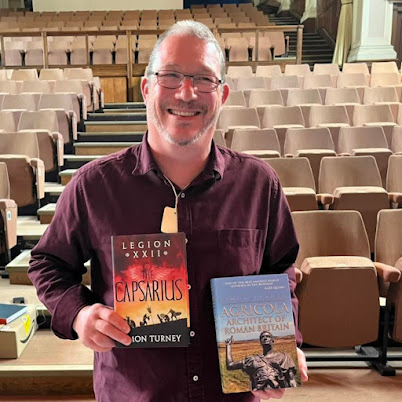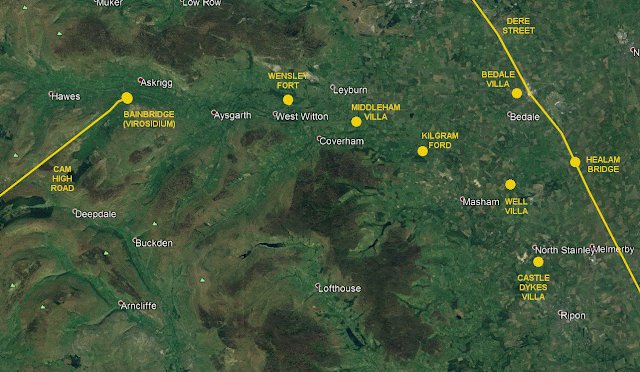Alright, so for anyone who missed it, this weekend was York's Eboracum Roman festival. An annual event that has sadly been absent from our lives for the past couple of years thanks to the damn virus. But Eboracum is back, baby, and despite Covid having changed everything and rail strikes making it difficult for visitors to attend, and even an uncertain weather forecast, the event went ahead and was a true success.
The writings, readings, and musings of an author of historical fiction who really should know better.
Monday 27 June 2022
Eboracum - A Roman Extravaganza
Wednesday 1 June 2022
A Grand Day Out: Roman Wensleydale
Fancy a trip out for a day, somewhere pretty and fascinating? North Yorkshire is certainly full of such places, but given my connection with Rome, I'm going to give you an idea for a trip along one of the country's lesser-known Roman routes.
Wensleydale is one of the more northerly Yorkshire dales, home to internationally famous brands, such as Wensleydale Cheese, Theakstons and Black Sheep beer, and Brymor Ice Cream. It contains some of the most important and impressive pieces of Medieval history in the country (some of this given as sidebars on this tour. But it was also a Roman road. For our purposes, the tour starts at junction 50 on the A1, for ease. From the junction, follow the B6055 north, heading towards Bedale. At a roundabout a few miles north, turn left for Masham. As you do so, take note of where you are. The main Roman route north on this side of the Pennines was Dere Street, which more or less follows the A1 for quite a way. The road was dotted at regular intervals with forts. You may have passed the one near Boroughbridge or the one at Catterick, depending on which direction you came, but now, at this roundabout, you are two miles from a Roman fortlet at Healam Bridge, directly between the two aforementioned forts. The site has been ploughed out and built over by the road, so there is nothing to see there, and we shall, instead, make our way west, into the Dales.
Follow the road for 5 miles. Halfway along, you will pass Thornborough on your left, home of three immense ancient henges of national significance, also worth a visit, though not part of this Roman tour. Instead, we are going to turn right for the village of Well. This small village, home to another brewery, as a matter of interest, is the site of a Roman bath house discovered in the 19th century. The baths probably belonged to a villa and although the site is now buried, a mosaic pavement removed during excavation can now be found in the church. Pop in and have a look for your first taste of Roman Wensleydale. This villa would have been close to the road that ran from Healam Bridge up the dale.
Return to the Masham road (B6267) and turn right. Follow the road into Masham, noting the Theakston and Black Sheep breweries up on the hill to your right. On another day, Masham church is worth a visit for its magnificently carved Saxon cross. On this occasion, though, we're heading through Masham without stopping, and now we are truly entering the dale. Follow the road from Masham for four and a half miles, and at a small, unobtrusive junction just past Brymor Ice Cream, signing Bedale again, turn right. This small road will take you around the edge of the Jervaulx estate for a mile, down to the medieval monastic Kilgram bridge over the river Ure. Park up beyond the bridge and walk back to it. Standing on the bridge, look down. The best viewpoint is on the north side of the river, looking upstream. Below the bridge you can see the very well-preserved remains of a ford. This predates the medieval bridge and shows signs of Roman construction techniques. This, then, is part of the Roman road that travels up Wensleydale, and you are standing where the legions crossed the river 1800 years ago.
Return to the main road and turn right at that junction you turned off at. You are now following the edge of the Jervaulx estate and if you look right at times you will see the impressive ruins of Jervaulx abbey (another fabulous place to visit that we are going to mosey on past on this occasion.) Incidentally, Jervaulx is a Norman French name and can be translated as Yore Vale. The dale was, until the 18th century, called Uredale, after the river Ure (Yore). Follow the road round past the abbey. You will go through the village of East Witton and over the lovely Cover Bridge, past a particularly good inn. Follow the road, and you will pass a bend or two, a farm by the roadside, and reach a straight. Blink and you'll miss the next bit. Look ahead and left. A field wall ends by a building with a tree. Behind that lie buried the remains of a Roman villa's bath house. You will probably not have the chance to stop and look, and the next thing you know you are in Middleham, home to one of Britain's most impressive castles and a childhood home for Richard III. Yet another place to remember for another time.
Follow through Middleham and across a lovely bridge, heading for Leyburn. On the other side, turn left for Wensley and Hawes. This cut through road, a mile or so long, leads you to the village of Wensley, past a church. Again, for future reference, the church is fascinating. Turn left past the church. The road will take you across the river. Look to the right as you travel. Beyond the trees, buried in a farm field, is a Roman fort. It is now long gone and ploughed out, but the site is important. Follow the road up the dale. It will take you past a chapel of the Templar knights near Swinnithwaite, a lovely waterfall at West Burton, Aysgarth, with its falls where Robin Hood, Prince of Thieves was filmed and where the church holds remnants of Jervaulx Abbey, and finally to the village of Bainbridge.
Just before you turn right and descend into the village, a huge hill on your right is crowned with the remains of Virosidium Roman fort. It is hard to appreciate the fort from the village, other than its impressive positioning. It is also on private farmland, so you can't stroll around it. You can, however, park up in the village, use an OS map and walk back the way you drove in, all the way up to Brough Scar, where a public footpath runs high along the side of the dale, and affords an impressive view of Virosidium that will allow you to understand and appreciate the fort.
Once you are finished with the fort and any walking, return to the village and drive on towards Hawes up the dale. When you reach the turnoff for Burtersett, turn left and head through that village. The road gradually climbs the valley side, then does some sharp bends, and then crosses a line of footpaths with field walls, with room to park. Stop there and look along those paths, up and down the slope. What you are looking at is called the Cam High Road. It is part of the Pennine Way. It is also the best section of the Roman road you've been following, this part leading up from Virosidium, over the Pennines, and down towards Ingleton and Lancashire. Roman roads in Britain are rarely so impressive and preserved, so savour this view. Then retreat the way you came to the main road up the dale. Turn left and you will soon come to Hawes.
Hawes is home to the Wensleydale Creamery, if you're a cheese fan, and a ropemaker's museum. It also houses the Dales Countryside Museum in the old station. This is your last Roman stop. Here you will find two Roman milestones found near Bowes on the A66, some Bronze Age artifacts, and a model of the Virosidium fort. It is a gem of a museum in many ways.
This is the upper end of Roman Wensleydale and the end of your tour. If you have the time and the money, it would be worth staying in the lovely town of Hawes, enjoying a night there, and then doing the reverse of this tour, but visiting all the sites I mentioned that we bypassed on the way back to the A1. You could do a lot worse. While you're at Hawes, you might also visit the waterfall of Hardraw Force. If you need extra aid in directions, any OS map of the area will probably be more than adequate.
Enjoy Roman Wensleydale. The Roman sites are not largely visitable or even visible, but they are there, and visiting them will give you the opportunity to see some of Britain's best countryside.






.png)



